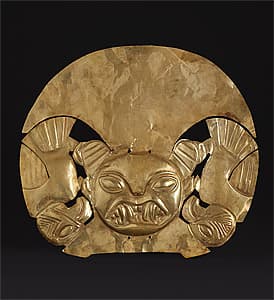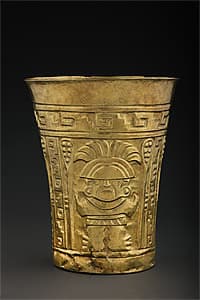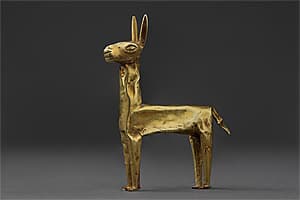Gold and the Incas
masterclass series
Each Wednesday 5 to 26 March
6.00 – 8.00 pm
Key academics and experts in the art of the Incas deliver masterclass lectures that delve deeply into the rich artistic content of the exhibition. Ideal for enthusiasts, the-one hour lectures are followed by an exhibition viewing from 7.00 to 8.00 pm.
Series $140, $120 concession, $100 members (includes four lectures and exhibition entries) | bookings essential | James O Fairfax Theatre
BOOK HERE
Single Sessions tickets are also available for purchase at the door.
Single sessions $35, $30 concession, $25 members
5 March
Christine Dixon
Senior Curator of International Painting and Sculpture at the National Gallery of Australia, Canberra, and curator of Gold and the Incas: Lost worlds of Peru. She co-curated the major exhibitions Turner to Monet: The triumph of landscape painting in the nineteenth century 2008, Masterpieces from Paris: Van Gogh, Gauguin, Cézanne and beyond. Post-Impressionism from the Musée d'Orsay 2009, and Renaissance 2011.
Gold and silver: Sicán and Chimú metalsmiths
Christine Dixon will discuss the extraordinary metalworking techniques of Sicán goldsmiths at Batán Grande and their relationship to the art of the Kingdom of Chimor. The general Peruvian preference for gold over silver was challenged by the Chimú: why was this, and what effect did it have on their culture?
12 March
Carlos Ramirez
Archaeologist from Peru. He has worked on a number of archaeological projects in both Peru and Ecuador. In Peru, Ramirez worked with the Brunning National Museum, Lambayeque on the excavation of the pre-Inca Royal Tombs of Sipan and a number of pre-Inca sites in the north coast of Peru; he was part of the archaeological team that worked on the Pyramids of the Sun and Moon in the Moche valley (capital of the Mochica culture), where he produced his thesis on the Pyramid of the Sun. He has also was a co-director of Huancaco pyramids archaeological project; a Mochica site in the Viru valley. Additionally, he worked on a range of sites in the Sacred Valley of the Incas near Macchu Picchu. In Ecuador, he was the Director of the Salango Museum and he is currently working at the National Museum of Australia.
The Discovery of the Royal Tombs of Sipan: New perspective on Pre-Inca and Inca cultures
The Royal Tombs of Sipan is located at the pyramids of Huaca Rajada, on the north coast of Peru in the Lambayeque valley. It was discovered in 1987 by the Bruning National Museum team.
Built during the Mochica culture (ca. 100–800 AD) the site consists of two small pyramids plus a low platform. Those tombs are burials containing grave goods as offerings including hundreds of clay pots; gold, silver and copper jewellery and the remains of servants to ensure survival of the elite into the afterlife.
This discovery is significant in the study of the Mochica culture as it was the first time that several intact tombs, with a large number of objects, were found in situ, providing a context to their use.
At Sipan, after seeing the image depicted on the objects, the continuity of certain representations and motifs through the Chavin, Moche and Inca cultures was noted. Stylistically, the portrayal of those motifs changed but the use and cultural significance of them remained, evidencing cultural continuity through the early to late Peruvian cultures. Many of the objects displayed in this exhibition contain these motifs and their meaning to the people of the Mochica culture will be explored in this lecture.
19 March
Ian Farrington
Visiting Fellow in the School of Archaeology and Anthropology at The Australian National University, having taught there since 1979 until he retired this year. He has conducted archeological fieldwork in Peru since 1971, with major projects focussed in the Moche valley, and in the Cusco area in the Cusichaca valley and Machu Picchu National Park, the Sacred Valley of the Inkas and Jaquijahuana. He is an inka specialist and study the last 2-300 years before the Spanish Conquest in 1532-3.
Farrington has written several papers and co-written two books; the latest is the first archaeological analysis of the city of Cusco, the inka capital, entitled: Cusco. Urbanism and archaeology in the Inka world, published by the University Press of Florida in 2013. He is a member of the Editorial Board of the leading journal for Peruvian archaeology, Boletín de Arqueología, published by PUCP in Lima. He has been decorated twice by the President of the Republic of Peru and is Comendador al Orden al Mérito por Servicios Distinguidos and more recently he received Peru's highest civilian honour, Comendador al Orden del Sol.
Felines, Kings and Shamans: aspects of ancient Peruvian art and society
Feline imagery has been a common motif in ancient Peruvian art from the beginning of artistic expression in the Andes about 5000 years ago to the Inka conquest and beyond. Why? The association of the feline in Amerindian mythology, shamanism and ritual has long been recognised, whilst the trance-inducing use of hallucinogens in such ritual activity has become the paramount paradigm for the interpretation of such imagery. As a consequence, feline representations are seen to be metaphors for prestige, power and prowess, as well as for status, strength and authority, in both physical and metaphysical senses. Indeed, as one leading Pre-Columbian art specialist has concluded in the ancient Americas '… the jaguar was identified with gods and with rulers and royal symbols' (Benson 1998: 53). In this presentation, the roles performed by both the puma and the jaguar in the changing developments of ancient Peruvian society and its art shall be explored.
26 March
Professor Richard L Burger
Charles J. MacCurdy Professor of Anthropology, Yale University. Richard became a member of the Yale faculty after receiving his undergraduate degree in archaeology from Yale College and his MA and PhD in anthropology from the University of California, Berkeley. He served as the Chairman of the Anthropology Department and the Council for Archaeological Studies at Yale as well as Director of the Peabody Museum of Natural History. In Peru he has taught at the San Marcos University and the Catholic University. An archaeologist specialising in emergence of civilization in the Central Andes, Burger has directed excavations at Chavin de Huantar and Huaricoto in Peru's northern highlands and at Cardal, Mina Perdida and Manchay Bajo on Peru's central coast. He also has pioneered the sourcing of obisidian and cinnabar in Peru in order to better understand ancient patterns of interaction and exchange.
Gold and the Origin of Peruvian Civilization
The appearance of gold metallurgy in the ancient Andes is entangled with the emergence of complex society and the linkage of this precious metal with supernatural forces and claims of sacred power by the religious leaders of the 2nd and 1st millennia BC. In this talk Prof. Burger will discuss the origins of gold-working on the Peruvian coast and its subsequent elaboration at religious centers in the northern highlands. The presentation will draw upon Burger's discoveries early gold artifacts at Mina Perdida and Chavin de Huantar, as well as the recent finds by his Japanese colleagues at Kuntur Wasi and Pacopampa. The development of metallurgy at these early sites laid the foundations for the famous golden treasures produced by later Moche, Chimu and Inca cultures.






